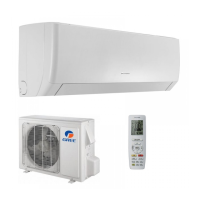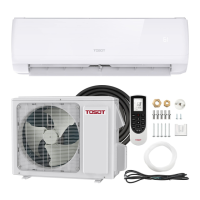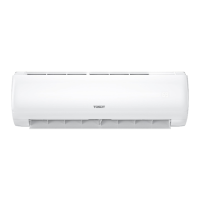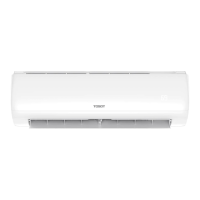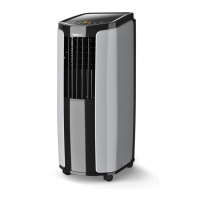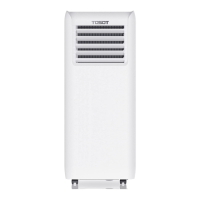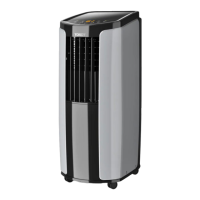Do you have a question about the Tosot GWH12QB-K3DNB4D/I and is the answer not in the manual?
| Cooling Capacity | 12000 BTU/h |
|---|---|
| Heating Capacity | 12000 BTU/h |
| Energy Efficiency Ratio (EER) | 3.21 |
| Coefficient of Performance (COP) | 3.61 |
| Refrigerant | R410A |
| Weight (Outdoor Unit) | 30 kg |
| Noise Level (Outdoor) | 52 dB(A) |
| Type | Split Air Conditioner |
| Power Supply | 220-240V, 50Hz |
Indicates a hazard that will result in death or serious injury if not avoided.
Indicates a hazard that could result in death or serious injury if not avoided.
Indicates a hazard that may result in minor or moderate injury if not avoided.
Indicates important information, used to indicate risk of property damage.
Safety guidelines for children, cleaning, socket usage, and handling damaged cords.
Warnings against washing the unit with water, spraying water, and using fire/hair dryers on filters.
Emphasizes professional maintenance and warns against DIY repairs or touching internal parts.
Highlights risks like blocking air inlets, spilling water on the remote, and abnormal operating phenomena.
Advises using insulated objects for the emergency switch and avoiding stepping on the outdoor unit.
Stresses qualified professionals for installation, following safety regulations, and using proper circuits.
Details requirements for circuit breakers, grounding, power cords, and wiring connections.
Warns against powering on before installation is complete and handling damaged cords.
Advises keeping cables away from copper tubes and ensuring proper grounding.
Covers national wiring regulations, professional wiring, and plug accessibility.
Details requirements for plug accessibility and circuit breakers for units without plugs.
Advises on professional relocation and selecting safe locations away from children and animals.
Specifies the operating temperature limits for cooling and heating modes.
Labels parts of the indoor unit like air inlet, panel, filter, and horizontal louver.
Shows the remote control with buttons like MODE, FAN, SWING, SLEEP, TIMER.
Describes indicator lights for cooling, power, receiver window, and temperature.
Explains the color codes for Power LED and Mode LEDs (Cool, Heat, Dry).
Identifies ON/OFF, MODE, +/- buttons and their basic functions.
Identifies FAN, SWING, SLEEP, and TIMER buttons.
Explains how to turn the unit on/off and cycle through operation modes.
Details using +/- buttons for temperature and FAN button for speed.
Explains how to select fan speeds (AUTO, SPEED 1-4) and notes for Dry mode.
Describes how to activate Sleep mode and set Timer On/Off.
How to activate/deactivate child lock using +/- buttons simultaneously.
How to switch between Celsius (°C) and Fahrenheit (°F) using "-" and MODE buttons.
Instructions for turning on, selecting mode, setting temp, and fan speed.
Steps for opening the battery cover, replacing batteries, and reassembling.
How to operate the unit using the aux. button when the remote is lost or damaged.
Warnings about disconnecting power, avoiding water, and using volatile liquids for cleaning.
Steps to open the panel, remove, and clean the filter using dust catcher or water.
Instructions for drying the filter and reinstalling it, along with warnings.
List of checks like air inlets, air switch, filter, and drainage pipe condition.
Steps for cleaning the filter and indoor unit panel after disconnection.
Guidance on recycling packing materials and proper disposal of the unit.
Solutions for when the indoor unit doesn't respond to the remote controller.
Explains why no air is emitted in heating mode or if temperature is reached.
Checks for power failure, loose plugs, tripped breakers, or wiring issues.
Explains mist formation and why temperature adjustment might be limited in auto mode.
Addresses poor cooling/heating effects due to voltage, dirty filters, temperature settings, or open doors/windows.
How to address odors and sudden abnormal operation due to interference.
Explains normal sounds like refrigerant flow and thermal expansion/contraction.
Lists error codes (E5, E8, U8, H6, C5, F1, F2) and their basic troubleshooting.
Lists critical phenomena requiring immediate power off and professional contact.
Specifies minimum distances from the ceiling, walls, floor, and obstructions.
Lists essential tools like level meter, drill, wrenches, and vacuum pump.
Advises on selecting locations free from obstructions and suitable for drainage and access.
Emphasizes following safety regulations, using qualified circuits, and proper wire connections.
Details grounding requirements, wire specifications, and disconnection switch needs.
Recommending and confirming the installation site with the client.
Steps to hang the frame, drill holes, and fix it securely to the wall.
Instructions for creating a piping hole, including its position and downward slant for drainage.
How to route the pipe from the indoor unit (right, left, rear) and cut bottom case holes.
Steps for connecting pipes using union nuts and tightening with a torque wrench.
Connecting the drain hose to the outlet pipe and securing with tape, with notes on insulation.
Instructions for opening the panel, accessing wiring, and connecting wires to terminals.
Routing the power wire through the unit and connecting it to the terminal.
Steps for bundling connection pipes, power cords, and drain hoses with bands.
Passing pipes through the wall hole and hanging the unit on the mounting frame.
Stuffing gaps with sealing gum, fixing the wall pipe, and checking for firm installation.
Lists items to check after installation for potential malfunctions.
Steps for preparing the client and performing the initial test operation.
Lists standard and minimum connection pipe lengths.
Table showing maximum pipe length and height difference based on cooling capacity.
Guidelines for adding refrigerant oil and charging refrigerant for longer pipes.
Table detailing additional refrigerant charging amounts based on liquid pipe diameter.
Steps for cutting pipes, removing burrs, and preparing for expansion.
Instructions for expanding the pipe port using an expander and checking the quality.




